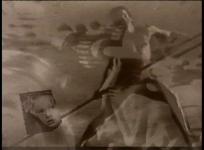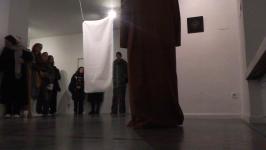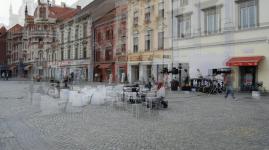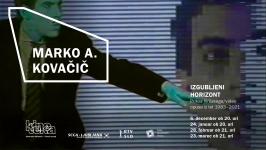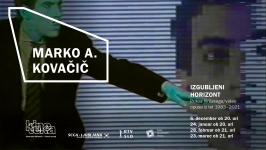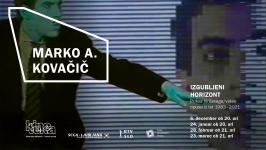Interview with Neven Korda concerning video Discipline. [Iz: From Consideration to Commitment: Art in Critical Confrontation to Society, on-line publication https://talkingcriticarts.wordpress.com/, Belgrade, Ljubljana, Skopje, Zagreb: 1990-2010; Publishers: SEEcult.org in cooperation with ForumSkopje; Kurziv - Platform for Matters of Culture, Media and Society; SCCA, Center for Contemporary Arts - Ljubljana / Artservis; The Association of NGOs Clubture]
Pleasure in Discipline
The video Discipline was created as a part of Borghesia’s music video series. The series is entitled The Triumph of Desire, which clearly refers to Leni Riefenstahl’s Triumph of the Will. Why did you choose such a title and how did you refer to the film?
Indeed, The Triumph of Desire is my title and it does refer to Riefenstahl, but on the other hand, it refers especially to the situation in which these videos were made. I made some parts of it after I was no longer part of Borghesia. Approximately six months after the break-up of the band, I chewed on The Triumph of Desire music video collection. I wanted to create a whole, and suddenly everything went down the drain. Despite this, I wanted to realise the project. The videos were made, which for me meant that a desire had triumphed. Hence, the title – The Triumph of Desire. The video series was then released in an edition of approximately 300 copies. The premiere took place at Kinodvor, then Kino Sloga, which still screened pornographic films. But it was the only cinema with a cinema video projector.
Did you refer to the Triumph of the Will also in a formal sense?
In the sense of art history, that is, formally, the video does refer to Leni Riefenstahl, of course. But I would like to point out that it doesn’t in the ideological sense. Leni Riefenstahl simply used new technology to construct a video-transmission (television) around the stadium. For me, it was above all about the personal level, a desire that had neither the (a priori) right nor the (objective) conditions to exist. It was actually the desire that produced the video(s). To this day, I still think this multilayered meaning of the title is very good. In addition, it is worth mentioning that, at the time, there was a difference in our conception of will and desire, which in a way also embodies the difference between NSK and Borghesia. The different conception meant a difference in the relation to society in general: what is important in a person? (Of course, this cannot be separated, but it can be interesting to analyse.) Is it the will to power, and it is then the will that triumphs; or is it a lifestyle, a way of behaving, of approaching one’s desire in the literal Lacanian sense? The conclusion is that there is no mirror, no level that we can break through and find this desire there; rather, the meaning of life lies in circling around this desire, in constantly feeding the desire by circling around it. To sum up, I can say that the title refers to the three levels of (artistic) work: the personal, formal and psycho-philosophical.
On the other hand, her film documented events in a specific temporal and geographic context. The momentum of Hitler’s ascent to power is related to the Olympic Games. Your work, Discipline, involves a turn, a critique, with fragments of time and space coming together in an emotive space. The story begins with black-and-white footage captured in the image of a television set. Is this a way of contextualising the video?
After all these years, I can analyse the video in many different ways. The intention of Discipline was never any placement anywhere. It is basically an intertwining of various levels: personal, historical and state (political). It is a story, a political video. It shows footage from the end of 1986 and the beginning of 1987. It was made in the autumn of 1987 as a reaction or description of the political situation in Yugoslavia at the time. The formal placement was of no significance in this – it is self-evident, spontaneous. I was very pragmatic: I master one tool; what form can I get from this? At that moment, the story crystallised and, on the basis of that, I made seven videos in two years. In a way, Discipline resembles Venceremos, in that both constantly zoom through space that is historical and electronic at the same time. The historical consciousness is created electronically; it is a constant journey from place to place. In Venceremos, this is more evident because there are fewer scenes, while in Discipline everything is more mixed. Discipline is basically very simple, naïve. It starts with a black-and-white historical introduction showing Macedonian housewives fighting over loaves of bread, which was a tragic moment in the nationalistic sentiment at the time: political manipulation, on the one hand, and people fighting with bread for bread, on the other.
There follow images of healthy bodies in motion (Triumph), intertwining with images from Metropolis, with the wheels of time. The music, whose rhythm reminds one of a smoothly running machine, is interrupted by children singing. The black-and-white image is replaced by a political collage from the 1980s, the rhythm remains. The video builds the experience precisely through its constant playing with the possibility provided by the technology of the media apparatus at the time. To what extent did you think you were determined or limited by this technology; or was the opposite the case and it actually provided a new possibility of expression?
The shots of Macedonian housewives were loaded onto a computer, which was our tool for making music and video. Then, the video continues with the images of Leni Riefenstahl, who travelled from Greece to Germany to film the Olympic Games in Munich. Yugoslavia is also on this route, and the bodies belong to the torch, and I also added shots from Metropolis. This represents an introduction, a sort of humanism, a story. Formal solutions proceed from the video itself; it is related to the use of the medium, similarly to a guitarist taking their guitar and playing, playing. The context comes later. But actually, this creates a space on the screen, which I worked on a lot at the time. Celluloid records the depth of the image. Thus, a film always has several planes, and it is important which is first, which the second and the third, since everything is done with shadows, and celluloid is capable of recording a certain number of points. As opposed to celluloid, it is not possible to achieve the same effect with the electronic image, since it is flat. From this flatness, with various frames and keying, I was able to create a multilayered plane which then created the impression of new spaces. These then spontaneously move according to the laws of video. And this was precisely the goal of the construction of video; that is, for the elements to move, to be constructed and consequently making the gaze to constantly move, stopping nowhere. It stops somewhat only at the end, perhaps as a declaration of war. So, what was important was the story, while the video enabled me to use electronics to express what I felt.
Everything in the video is moving: children’s faces; the calendar is turning; the bodies, the wheel work. It is about the feeling of a Human Being. There follows a children’s choir singing ‘Serbian-Yugoslav’ political slogans. At the time, people at Radio Študent were making fun of these slogans. They had a whole series of texts in their programme. We took them from their jingles, organised a children’s choir to record the song in the studio, which I also shot on video: "Slobodane slobodom te zvali, tebe vole veliki i mali. Dok se Slobo ovom zemljom kreče, narod nikom robovati neće. (Slobodane, they call you freedom; you are loved by old and young alike. While Slobo is around, the people will be slaves to no-one.)" These lines, the situation in Serbia that made such lines possible, were something unreal. It seemed incredible that something like that could be happening. Even today, I still find it hard to believe. We were alive and we were powerless. Nonetheless, the children are singing, and then the words "new Tito" appear as something funny, as a question of how this is even possible. Four people are completely powerless; each is closed in their powerless world. While chaos unfolds outside, you yourself can do nothing.
In the meantime, the layer of history from the first part has already seeped into the viewer’s subconscious. Could you say that history is repeated through new images, with new technology?
Yes, although I did not think about it formally; it comes from the images themselves, but it is actually that. All - for example, the universal scenes from Metropolis - ultimately represent a romantic view of history that breaks after the caption ‘Jugoslawien’ appears. The next montage is of barbed wire with Kosovar Albanians: Milošević’s ideology as a kind of concentration camp. The image with the children in the choir that follows is an ironic comment on the image that all totalitarians want to create: the image of being celebrated in kindergartens. This refers not only to Tito, since a political apparatus of this sort was present everywhere in the world: in the US, France. Between 1958 and 1968, De Gaulle ruled France as a sort of a dictator. He assumed the power that was brought down in 1968 by the students. If we compare the US context with Truman (and its later presidents) and their propaganda films, we can see that it was the same as Tito’s. With Milošević, on the other hand, the turn of politics at the global level, this global retro- wave to known patterns of late 19th-century international politics (world management) became evident. Something that later actually happened. It was incomprehensible. For years and years, generations had grown up in the belief that WWII was the last war that could happen. All was clear; yet it was all repeated. And this disbelief, the disbelief that it was possible, was the theme of the video. At the same time, it was important for me that the theme was nicely realised, lavishly, in a baroque style, which holds also for the other videos in The Triumph of Desire series.
The media chaos of political collage somewhat ironically becomes only an image on a TV screen. We move from an emotive image into personal space. The television screen with Milošević’s image lands between the naked legs of a person eating popcorn. Immediately after this: your image in front of a mirror. We meet four people that we then follow through the music to the end of the video. Each of them is portrayed in their ‘intimate space’, which reveals the confusion of their own existence. The camera does not even try to objectively present this space. The corners are potentiated, as well as the zoom-ins, the presentation of spatial fragments, quick cuts. What kind of a world does it attempt to present, and why is personal space in this part present as such? What are its essential components?
This space is generically constructed. The goal was to create a generic image, which in a sense announced the techno of the 1990s and the pleasure in it. Anyway, it was the flats in which we actually lived. Aldo is in his flat, in front of his TV. I am at Borghesia’s place. In addition, we made arrangements with someone else to film shots with smaller images - that is all the scenes shot by chroma keying. All those scenes were shot in the flat with Dario, while Zemira was in Dario’s flat. I wanted to have flats where these alienated persons are closed within themselves, but everything seems as if it were going on in everyday flats. It is about a sort of powerlessness, urban powerlessness.
The video again changes into an image of imaginary space created by layers of sound and images, but among the hypnotic images, there also appear the faces of the four people we ‘met’ before in the private space. Now, they drown in the ‘rhythm’ of discipline and colours. In this space, there also appear icons of the classical ideal, the ‘striped dancing torso’, images reminding one of the Rorschach test. As a public image of the collective subconscious created through pop iconography. Which elements of pop culture did you interpret?
There are also a lot of dance scenes with Dario and Zemira that are meant to be very focused on dance and very effective, and created by chroma keying. It all came out looking very ‘Greek’, magnificent, which was brought about by the spontaneity of working with the medium. I obviously needed a certain story in the first place; while this elaborate classicistic beauty came by itself and surprised me, too. The video is about discipline. In Slovenian, this noun is plural, but the lyrics are in English, so the noun is singular. I conceived it in a very humanistic way, since the geometric shapes that appear are Eastern pictorial mantras with charkas, and partly the ground plans of 17th-century penitentiaries that have a similar structure to the charkas. Since that was something I was studying at the time, it seemed great to me. The development of humanism went beyond limitation. At that time, the architecture started becoming more thought-out, precisely in the cases of fortifications, prisons and other state institutions. That is what disciplines are, humanism that had led us to unexplored territory, a sort of a romantic view of humanity and the modern age. At the time, the Gulf Wars had not yet started, but soon, in the 1990s, there came the Yugoslav Balkan war, the live broadcast of the first Gulf War...I also have videos about that - Gagarin, for example. It is the same question: what is democracy, humanism? In the 1980s, the global political situation – I do not mean the alternative scene – began to turn into a sort of slavery, religiosity. Suddenly, the answer to the civil state was Islamism, a religious state, as it were. Our answer (via Regan, Bush, Milošević, Tuđman) was to erase the separation of church and state. They speak of the nation, but the parameter that defines them is religion. I don’t know - Orthodox Catholics, Catholics, Muslims - all this twisting was visible in the 1980s. The entire world…Somalia. I then realised that it was Islamic fascism. All this appears as a sort of a disco element of a sort of psychedelia through spinning, electronic zooming, in the sense of the approaching techno, which is the essence of video. But for me, the content was the most important, and only then came this beauty and video manipulation.
Discipline is followed by punishment. The faces disappear among faces. The image of a lost measure, the disorientation of the erosion of the image. The word ‘punishment’ sounds as if it were coming from a loudspeaker, from somewhere else. Why?
There follows a series of images with the text “punish them”. This is actually the image of Eisenstein from the 1920s speaking in front of a microphone. I scratched the image (also the concept that entered the broader scene in the 1990s) so that it seems as if he were saying “punish them”. Eisenstein, who is supposed to represent a sort of a revolution in the story of humanism, something good, is precisely the one saying “punish them”. Then a child runs, the scenes from Brazil, office work, '84, Orwell, an excerpt from Midnight Express, when they punish, whip the soles of the feet. Here, I wanted to show metaphors of violence. At the end, fanatical women, Catholic women walking on their knees a few kilometres around a church, flogging themselves. There follows an ordinary cinematic sado-masochistic scene mixed with Catholic eccentricity. So, the forced manipulation of the state the entire time. On the other hand, these are all types of discipline, including the eccentric Catholicism and S&M; it is a sort of pleasure in discipline, which was our slogan in the 1980s. Because if you want to take pleasure, you have to develop into a discipline. Things are connected at several levels.
Despite the video obviously referring to the political situation in Yugoslavia in its last gasps, the themes through which the video questions this situation are part of the international video scene. Which movements at the time did you relate to as a group?
I have to say that, at the time, I myself, as well as Borghesia, felt entirely confident in what we were doing. I felt totally confident in video. It seemed to me that I was the one who found it interesting, that there was nothing else. Although it again depends on what you talk about. There are various segments of video, from the gallery, art history…but I thought that with these videos, both in the sense of music and ideology, I realised the spirit of the time, which we wove just so, not even wanting to. As for the videos and concerts, we were at a very high level in the sense of our way of thinking and quality of realisation, but Borghesia was a small group. And so the video was created for small groups of viewers around the world. In other videos, too - for example, in Venceremos - all the techniques are stylistic, although the generic image with a purpose is characteristic of Discipline. But all the styles were up-to-date, something entirely fresh. All the time, something new was appearing - in the sense of new technology. Discipline was made almost two years after Venceremos in the same studio, but the approach to technology was different because new ‘toys’ had emerged. Of course, I, too, personally developed in those two years, but the toys were an important part of this process.
In the video, the grotesque aesthetic - the aesthetic of the ugly - gnaws into the space of the bodies that drown in the media image of strong rhythm. Could it be understood without music? Which came first: music, video, or neither?
With all the videos, the music was created first. The videos follow very closely the stylistically different music in 3D; they are made to music; they are solutions that result from following and surrendering yourself completely to the music.
In the video, there also appears the Ljubljana Skyscraper. The editing is reminiscent of the realisation of Bauhaus collages. Why such iconography, why architecture, and especially why architecture that is set against political slogans? Why is this image the one that breaks the series of grotesque images?
That is true, and that image is very urban. On that spot, at the time, they had just built the SKB building. Until then - two, three years before - there was scaffolding there. Slavija and the Skyscraper still seem to me one of the most beautiful modern parts of Ljubljana. The sky in the background then changes, which comes from Eisenstein. In the background, there appear multiplied shots from Eisenstein’s film, but again through generating, as if we were going through certain processes. Because of the technology at the time, you had to scratch the outline of the Skyscraper and Slavija by hand on a sort of tablet and you could not afford to make a mistake. If you did, you had to do everything all over again. And this is important; all these videos are very hand-made, which meant that one scene would necessitate the next. Once you see that one thing is rich, you then endeavour to make the rest the same. It is truly something living, something in the making and at the same time very contemplative.
But here we can also perceive an image of public space as opposed to the previously portrayed private space. And we could say that this space does not exist, that the Skyscraper is represented as an icon. The images in the last part of the video appear behind shots of tanks with a pop starry sky. The video slows down, the figures are set against a black background; the background has disappeared. Only the faces remain. Are these faces ultimately revealed, freed; are they bereft of their own space, or both?
One can look at this through the general genre of video in which the moment for a promo photo of Borghesia as a band is in a characteristic skyline of their city. The people you follow through the video are completely powerless at the end. As if they would like to breathe; and they do not breathe, into nothingness, the vacuum. As if you were watching a film happening in New York, but there was only fog, and someone turned off the lights of New York. Complete powerlessness. And, at the end, the tanks that are supposed to symbolise the incestuous relationship between the communistic ideology, which Yugoslavia actually wasn’t, and the nationalistic, then already fascistic ideology of ‘Serbo-Yugoslavia’ connected to religion.
Interviewer: Nika Grabar
